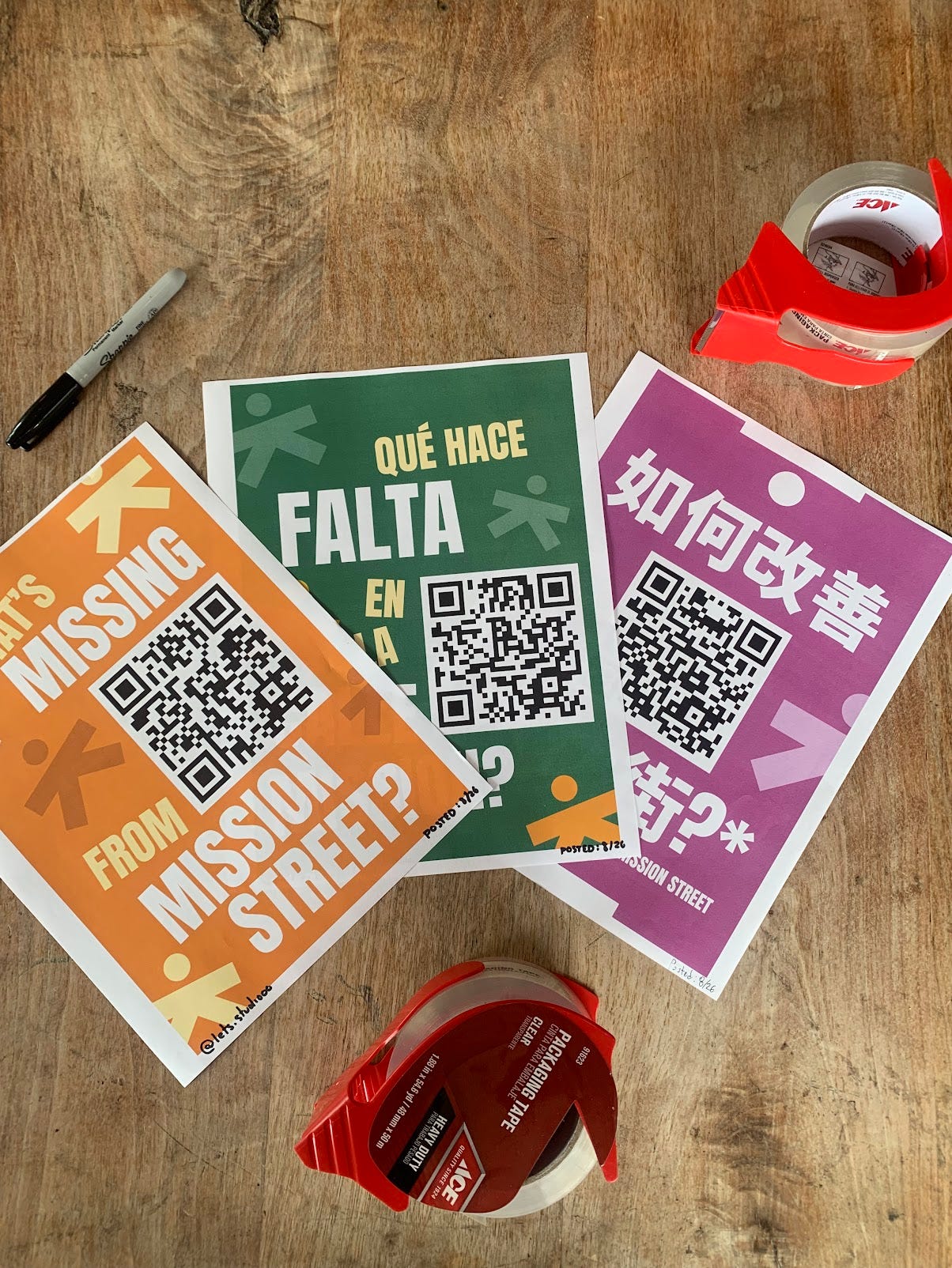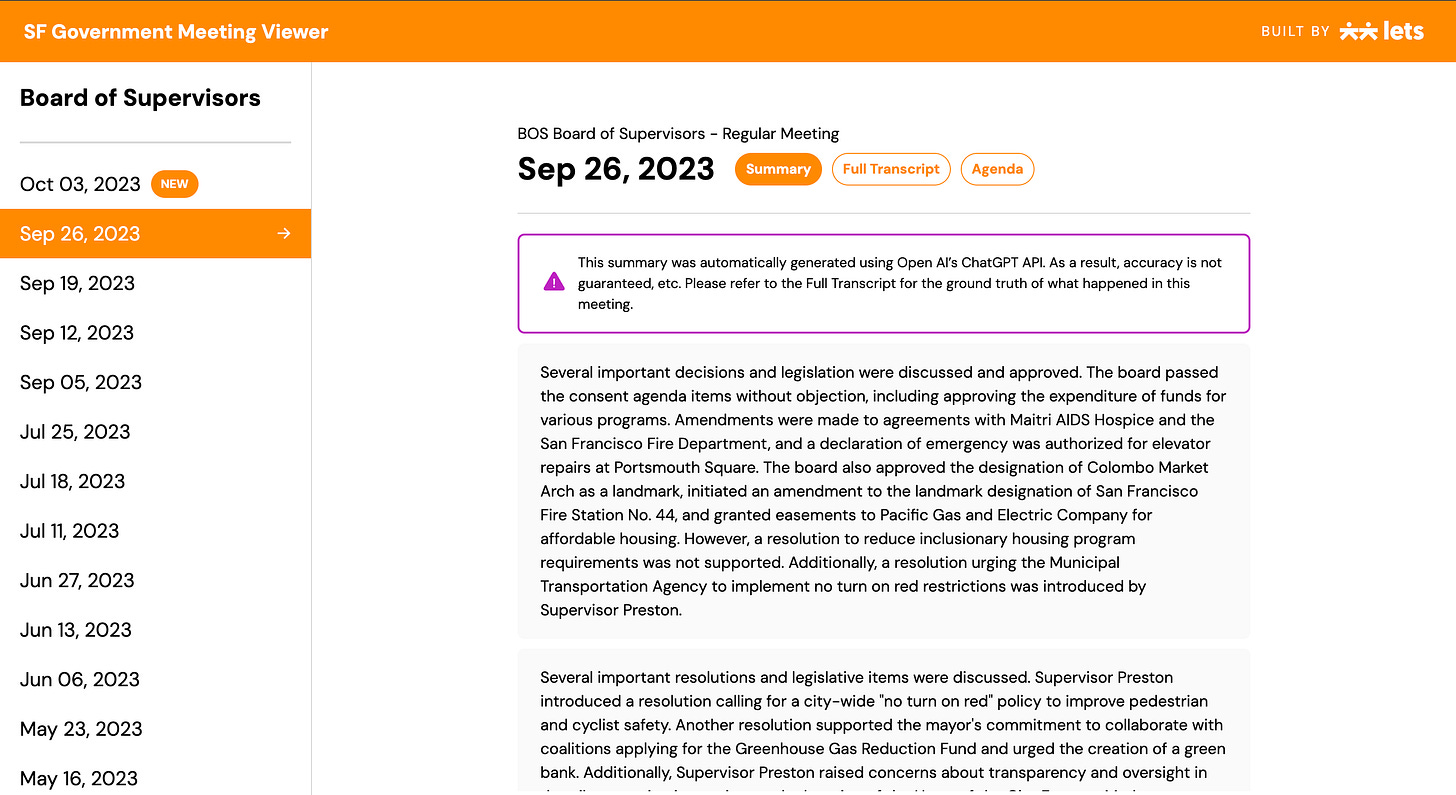LETS helps communities across the Bay Area channel their collective wisdom and creativity into place-based solutions. To work with us, check out our website or send a message to hello@letsstudio.org.
Given that LETS was officially founded in the latter half of 2023, it might seem a little silly to write a whole yearly review – after all, a year hasn’t quite passed yet!
And yet, a lot more happened than I originally expected. Under this new umbrella for our work, LETS found its first client, created a web tool to summarize public meetings, experimented with a new way to do public outreach, and probably jotted down a hundred new ideas for the future (all of which you can read more about below). In my personal endeavors, I’ve also been lucky to find mentors and collaborators through my studies at the Goldman School of Public Policy, all of whom have reinforced my understanding of the opportunities and challenges of this work. Maybe I shouldn’t be so surprised; after all, starting LETS was a dream of mine for years before it was officially created, and now all the energy and ideas have an outlet.
The key word for 2023 was experimentation. Even after many years of living in the Bay Area, I’m constantly learning more about the landscape of problems here and the solutions that various organizations, government agencies, and grassroots movements are putting into action. The legacy of democratic social innovation here is deep; contributing to this history requires moving with self-awareness and intention. As such, the activities that LETS does – supporting other organizations in enhancing public participation in their plans and programs, or increasing the community’s capacity for thoughtful participation – will also shapeshift as I learn more.
With that, here a few highlights of what LETS has done so far:
Client Highlights
As mentioned above, a big part of LETS’ work is to work with public-serving institutions to help them engage local communities productively. To that end, we worked with the amazing folks at Civity over the course of the year. Civity is a national nonprofit dedicated to helping people to empathize with one another and build trust to collaborate effectively in the long term. Their signature offerings – workshops and trainings on building authentic relationships – have helped communities across the country tackle everything from political polarization to climate change.
This time around, LETS supported Civity in an ambitious project of great importance to the Bay Area: helping communities throughout the Bay Area unite in the face of severe housing shortages, and see the full breadth of housing need in their communities. Throughout the project, LETS provided both strategic thought partnership and hands-on assistance; I defined the outreach strategy for both community organizations and government partners in the South Bay, and formulated a comprehensive engagement strategy once partnerships began to emerge. I also came up with a strategy for a storytelling component of this work, through which we interviewed residents of these communities about their backgrounds and how they relate to the housing crisis.
While I’m stepping away from this work in 2024, I’m confident that Civity’s community-based work can play a significant role in addressing this persistent issue.
Community Experiments
I believe that a community-based practice should proactively nurture its relationships with people where it operates; as such, it’s my intention that LETS works more directly with communities in the region outside of client projects. While this is part of the practice is ongoing, I found the time to do a quick experiment in my old San Francisco neighborhood through a simple question: “What’s missing from Mission Street?”. The experiment here was in the medium; rather than post the form online (which might get responses from people outside of the locality) or through email lists (which can be difficult to procure and introduce sampling bias), we decided to try using physical posters that would guarantee that those filling out the form were in the Mission District. With the help of a few volunteers, we designed some eye-catching posters in three languages and a QR code leading to a form, where residents could add whatever ideas came to mind.

We ended up not getting quite as many QR scans and responses as we would have liked, but we still learned plenty. Residents and workers of the Mission consistently called out a number of different needs in the community, including more housing, public restrooms, and cleaner streets (and, for one resident, a roller skating rink). Ultimately, we saw around 20% response rate for those who visited the form – not too bad, but we would clearly need to experiment more with this particular medium of engagement to improve the response rate. We have lots of ideas to return to whenever we do local outreach next.
Digital Experiments
As someone whose career has developed through building digital products and experiences, I have a lot of perspectives on the role that technology can play in driving social innovation. It’s absolutely not a cure-all, especially when dealing with complex public problems; there are usually many layers of policy, cultural change, resource coordination, and other components that have to come first. And yet, the last few decades of technological innovation can offer a universe of information and a voice to just about anyone with access to the internet. With a little thought and elbow grease, there’s enormous potential to build tools for collective empowerment.
One of the most obvious places to start is in making the operations within government more transparent, such that people have a better idea of what decisions are being made and how they can influence them. So with the help of a friend and collaborator (Noah Picard), we created Viewer: a website that automatically generates simple summaries of public meetings. Users can easily find the recent meetings of a given government body (such as the Planning Department or Police Commission) and immediately access a five-paragraph summary of what happened during that meeting; you can also dig deeper into any part of the meeting by clicking on the relevant paragraph of the summary.

Right now, we’ve started by summarizing recent meetings of the San Francisco Board of Supervisors. This is just a foundation of what is possible; we’ll likely continue to build on this example in 2024 towards a more public launch, and are seeking community-based organizations, journalists, and others to design and build alongside. In the meantime, if you’re interested in testing the tool, feel free to reach out to us (hello@letsstudio.org), leave a comment here on Substack.
Onward to 2024
Looking back, I’m immensely thankful to everyone who helped to bring these projects to life. Actively working on LETS has been a dream of mine for years now, and to have taken the first couple steps towards making it a reality has been deeply affirming.
At this time, there are a few things that we’d like to focus on in the new year:
Building a community of practice around collaborative, community-centered design. Service designers, planners, and grassroots organizers are all deeply involved in bringing about social change, and each can more deeply collaborate with affected communities to create public solutions. I’ve been blessed to meet people in all three categories who are dedicated to community-driven change; it’s high time they all came together to share best practices and coordinate on initiatives where possible.
Enhancing existing public forums between everyday residents, organizations, and government agencies. It’s no secret that there are some places for community engagement; community listening sessions and focus groups are fairly common practices for planners and other civil servants. And yet, these existing forums often draw unrepresentative crowds and fail to define how community input will be incorporated into final plans. This year, LETS will take on the challenge of identifying where these forums exist to address pressing issues in Bay Area cities, and then work with government and nonprofit partners to facilitate local wisdom into promising, home-grown solutions.
Creating new community-owned forums for civic discourse. Sometimes, we get so wrapped up in the technicalities of collaborative design that we forget that gathering and conversation is something that comes fairly naturally to us. I’d like to bring that energy back in 2024, starting with simple conversations with neighbors – what brought them to the city, what they love about it, what they wish was different about it, and more. With luck, some of this energy can also support healthy conversations about specific issues in the city and what we should do about it.
To reiterate the theme from before: we’re still in a very experimental phase of LETS’ growth. For each of these priorities, I’m trying to not overthink things and start with simple experiments, which I will try to document here. I’m also trying to ask for help more, so let me know if any of this sounds exciting and I’ll loop you in. In any case, I’m feeling optimistic about these initial directions; building the capacity for collaborative governance in the Bay Area needs to start by connecting the dots and enhancing what already exists.
With that – let’s make things happen in 2024! Whether you’re a potential client, collaborator, or cheerleader, don’t hesitate to reach out to me at hello@letsstudio.org.
With light,
Humphrey Obuobi




